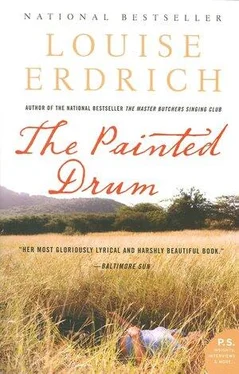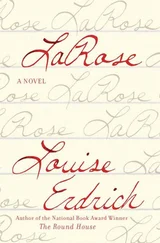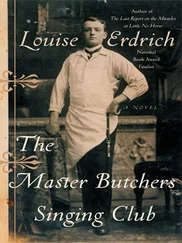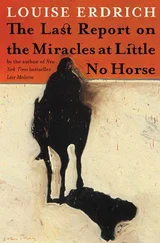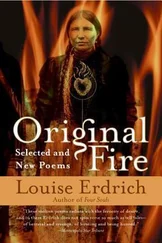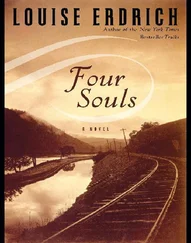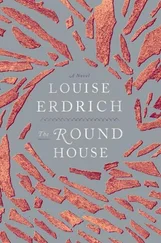Louise Erdrich
The Painted Drum
1 Revival Road Faye Travers
Leaving the child cemetery with its plain hand-lettered sign and stones carved into the weathered shapes of lambs and angels, I am lost in my thoughts and pause too long where the cemetery road meets the two-lane highway. This distraction seems partly age, but there is more too, I think. These days I consider and reconsider the slightest of choices, as if one might bring me happiness and the other despair. There is no right way. No true path. The more familiar the road, the easier I’m lost. Left and the highway snakes north, to our famous college town; but I turn right and am bound toward the poor and historical New England village of Stiles and Stokes with its great tender maples, its old radiating roads, a stern white belfry and utilitarian gas pump/grocery. Soon after the highway divides off. Uphill and left, a broad and well-kept piece of paving leads, as the trunk of a tree splits and diminishes, to ever narrower outgrowths of Revival Road. This is where we live, my mother and I, just where the road begins to tangle.
From the air, our road must look like a ball of rope flung down haphazardly, a thing of inscrutable loops and half-finished question marks. But there is order in it to reward the patient watcher. In the beginning, the road is paved, although the material is of a grade inferior to the main highway’s asphalt. When the town votes swing toward committing more money to road upkeep, it is coated with light gravel. Over the course of a summer’s heat, the bits of stone are pressed into the softened tar, making a smooth surface for the cars to pick up speed. By midwinter, the frost creeps beneath the road and flexes, creating heaves that force the cars to slow again. I’m glad when that happens, for children walk this road to the bus stop below. They walk past with their dogs, wearing puffy jackets of saturated brilliance—hot pink, hot yellow, hot blue. They change shape and grow before my eyes, becoming the young drivers of fast cars who barely miss the smaller children, who, in their turn, grow up and drive away from here.
As I say, there is order, but the pattern is continually complicated by the wilds of occurrence. The story surfaces here, snarls there, as people live their disorder to its completion. My mother, Elsie, and I try to tack life down with observation. But if it takes a lifetime to see things clearly, and a lifetime beyond, even, perhaps only the religious dead have a true picture of our road. It is, after all, named for the flat field at its southern end that once hosted a yearly revival meeting. Those sweeping conversions resulted in the establishment of at least one or two churches that now seem before their time in charismatic zeal. Over the years they merged with newer denominations, but left their dead sharing earth with Universalists and Quakers and even utter nonbelievers. As for the living, we’re trapped in scene after scene. We haven’t the overview that the dead have attained. Still, I try to at least record connections. I try to find my way through our daily quarrels, surprises, and small events here on this road.
We were home doing pleasant domestic chores on a frozen Sunday in the dead of winter when there was a frantic beating at our door. In alarm, Elsie called me. I came rushing from the basement laundry to see a young man standing behind the glass of the back storm door, jacketless and shivering. I saw that he’d lost a finger from the hand he raised, and knew him as the Eyke boy, now grown, years past fooling with his father’s chain saw. But not his father’s new credit-bought car. Davan Eyke had sneaked his father’s new automobile out for an illicit spin and lost control coming down off the hill beside our house. The car slid toward a steep gully lined with birch. By lucky chance, it came to rest pinned precisely between two trunks. The white birch trees now held the expensive and unpaid-for white car in a perfect vise. Not one dent. Not one silvery scratch. Not yet. It was Davan’s hope that if I hooked a chain to my Subaru and backed up the hill I would be able to pull his car gently free.
My chain snapped, and the efforts of others only made things worse over the course of the afternoon. At the bottom of the road a collection of cars, trucks, equipment, and people gathered. As the car was unwedged, as it was rocked, yanked, pushed, and let go, as different ideas were tried and discarded, as the newness of the machine wore off, Davan saw his plan was lost and he began to despair. With empty eyes, he watched a dump truck winch his father’s vehicle half free, then slam it flat on its side and drag it shrieking up a lick of gravel that the town road agent had laid down for traction.
Over the years our town, famous for the softness and drama of its natural light, has drawn to itself artists from the large cities of the eastern seaboard. They have usually had some success in the marketplace, and can now afford the luxury of becoming reclusive. Since New Hampshire does not tax income, preferring a thousand other less effective ways to raise revenue, wealthy artists find themselves wealthier, albeit slightly bored. Depending on their surroundings for at least some company, they are forced to rely on those such as myself—a former user of street drugs cured by hepatitis, a clothing store manager fired for lack of interest in clothes, a semi-educated art lover, writer of endless journals and tentative poetry, and, lastly, a partner in the estates business my mother started more than fifty years ago.
At any rate, one such artist lives down at the end of our road, in a large brick cape attached to a white clapboard carriage house (now studio). Kurt Krahe—last name correctly written with an umlaut, a vampire bite above the a —is a striking man. Formerly much celebrated for his work in assemblages of stone, he has fallen into what he calls the Zwischenraum , the space between things. Kurt has lost his umlaut to American usage, but he loves German portmanteau words. Sometimes I think he makes them up, but Zwischenraum is real. It is the way I see the world sometimes. Kurt has fallen into the space between his own works and is now mainly ignored. He hasn’t done a major piece in years. Often, his sculptures incorporate native slate or granite and to help with the massive project of their execution he occasionally hires young local men. Krahe’s assistants live upon the grounds—there is a small cottage sheltered by an old white pine—they are to be available for work at any time of day or night. There is no telling when the inspiration to fit one stone a certain way upon another may finally strike.
Kurt’s hands are oddly, surprisingly, delicate and small; they remind me of a burly raccoon’s hands, nimble and clever. His feet are almost girlish in their neatly tied boots, a contrast to the rest of him, so boldly cut. I’m always curious about the stones that Kurt chooses for possible use. I inspect the ones he’s kept and I think I know, sometimes, what it is about them that draws him. He says that the Japanese have a word for the essence apparent in a rock. I ask him, why don’t the Germans? He says he’ll think one up. I suppose that I love Kurt for his ability to see that essence, the character of the rock. Only, I wish sometimes that I were stone. Then he would see me as I am. Peach-colored granite with flecks of angry mica. My balance is slightly off. I suspect there is another woman—maybe on his trips to New York City—but he has deflected and laughed off my questions. He has implicitly denied it, and I haven’t the confidence, I cannot bring myself, to ask him point-blank. Still, in spite of my suspicions, I am leaning toward him, farther, farther. Do I right myself? This is not an aesthetic choice.
Читать дальше
